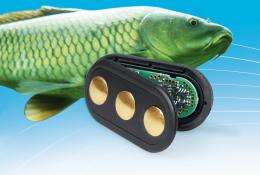Health check for fish

Fish in fish farms are exposed to very high health risks. Owing to the cramped conditions, pathogens quickly spread. In future, wireless miniature sensors implanted under the skin of the fish will help to prevent diseases, by monitoring and diagnosing their health.
Aquaculture is the fastest growing sector of the food industry worldwide. According to statistics gathered by the World Food and Agriculture Organization FAO, the production of fish, mussels and other shellfish in aquaculture has increased by about nine per cent annually since 1990. The reasons for this are the overexploitation of natural fishing areas and the rise in fish consumption due to a growing world population. But intensive farming is detrimental to the health of the fish, who have to live in cramped conditions that often exceed the recommended population densities, where parasites and diseases can spread very quickly.
To fight infections, extensive use is made of antibiotics, traces of which inevitably end up on consumers' plates. In the "FischFIT Monitoring" project, research scientists at the Fraunhofer Institute for Reliability and Microintegration IZM in Berlin have developed a tiny sensor system to combat this problem in advance. The system continuously monitors and diagnoses the health and behavior of farmed fish. The project partners are ELBAU Elektronik Berlin, the Leibniz Institute of Freshwater Ecology and Inland Fisheries Berlin and the Institute of Agricultural and Urban Ecological Projects at the Humboldt University of Berlin.
"Our FischFit Monitor is a microsensor system comprising five separate sensors with wireless data communication functions. Implanted under the skin of the fish, the sensors not only measure the skin resistance, blood pressure, heart and respiratory rate as well as the body temperature, but also their swimming behavior and movement activity. They therefore register how quickly a fish swims and whether it is moving hectically. On the basis of the measured data we can quickly identify any changes in behavior and draw conclusions about the health of the fish", explains Dr. Volker Grosser, who leads the IZM research group. "The sensor systems available up to now have usually only measured the body temperature of the fish and the temperature of the water. Fish in aquaculture are often not even monitored at all."
The microsensor system consisting of a material compatible to fish incorporates a special feature - its battery can be recharged wirelessly under water. The base station, which functions as a read/write device, transfers the measured data by Bluetooth or cable to the computer with the analysis software. The base station receives its power from the laptop. "The FischFit Monitor is only suitable for freshwater aquaculture, for use in ponds, rivers and tanks. Saltwater disrupts the radio link between the sensor and the reader unit. In fish farms, the reader unit is fastened to the edge of the tank. In rivers and ponds it is attached to the feeding stations. The FischFit Monitor functions even under extreme environmental conditions", states Grosser.
The present demonstrator is four centimeters long, two centimeters wide and eight millimeters high. The aim is to reduce these dimensions considerably. The device has already been implanted in carp and initial data transmission tests were successful. In future the research scientists intend to use the system in game fish aquaculture, for example for the production of sturgeon. The FischFit Monitor could also be adapted for use with mammals, in particular livestock such as cattle and pigs.
Provided by Fraunhofer-Gesellschaft
















